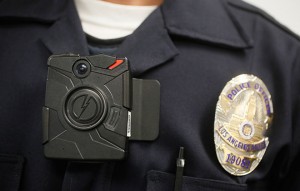
FILE- In this Jan. 15, 2014 file photo a Los Angeles Police officer wears an on-body camera during a demonstration in Los Angeles. The Los Angeles Police Department’s effort to equip officers with body cameras has run up against an unlikely obstacle, the ACLU of Southern California. The civil rights organization sent a letter Thursday, Sept. 3, to the U.S. Justice Department urging it to deny funding for the cameras until the LAPD revamps its camera policy, which the ACLU said is seriously flawed. (AP Photo/Damian Dovarganes, File)
Police Department got a strange request from a local citizen.
The SPD had been running a pilot program in which officers wore body cameras, and the person was asking for access to every piece of footage the department had collected up to that point.
Under the Freedom of Information Act (FOIA), the agency had a legal obligation to hand over the footage. But from a logistics point of view, the request was a mighty undertaking. There was no easy way to blur sensitive information in all the files and get them to the resident.
Ultimately, the department managed to get the footage over, but to avoid similar hassles in the future, it wrote some experimental code that heavily blurred people’s faces and addresses. The idea was that this software could allow people to comb through an “over-redacted” catalog so they could find and request just the footage they needed.
Today, that experiment is on the way to becoming a commercial product that any department can adopt, in the form of a service called CrimeReports.
Already in use at 1,100 police departments around the US, CrimeReports compiles body-cam footage uploaded by police departments in a searchable database. Users can conduct online searches based on location, date, and crime type.
If there is footage available for the particular incident they want, users can view the over-redacted preview through the website. If it seems relevant, they can submit a FOIA request (like the Seattle citizen did) for the lightly redacted version, which can be viewed in a secure online portal called the CommandCentral Vault. (Even the FOIA-approved footage will often be redacted to comply with local laws that protect citizens’ identities.)
The service is expected to hit the general public by mid-2017, says Tom Guthrie, vice president of Smart Public Safety Solutions at Motorola Solutions, which helps log the footage in CrimeReports.
Ultimately, the goal is to help people feel safe and build trust between citizens and law enforcement through increased transparency. But making footage available up front also saves agencies time, since it cuts down the amount of footage police department staff have to gather, redact, and send. Instead of combing through hours of video, they can easily select a two-minute clip.
Robin Jones, senior vice president at Socrata, which runs the actual CrimeReports interface, says that transparency could also help police do their job better. If citizens have greater access to public camera footage, they could submit tips to their local agencies if they suspect someone is stealing packages from a neighbor’s porch or vandalizing a library, for example.
And even if cops don’t want to wear body cameras, local businesses and private residents can register their cameras with the local PD to be used as public records in the database.
Body-worn cameras have become a major point of discussion over the last couple years as police killings continue and make national news. Earlier this year, however, an Associated Press review found cities have been slow to adopt the technology due to costs and resistance from police unions.
Guthrie hopes CrimeReports could persuade law enforcement to prioritize building the kind of trust that has been waning recently. If citizens and police officers could both hold one another accountable, maybe the investment in transparency could work out.
“We want to create an environment of citizen engagement” within law enforcement, Guthrie tells Business Insider. “And part of that is if you want them to help provide you with information, you provide them with open information. So I think we’re helping our customers take that first step.”
http://www.businessinsider.com/motorola-solutions-body-cam-footage-public-2016-10

